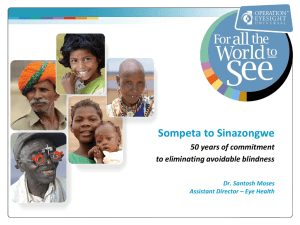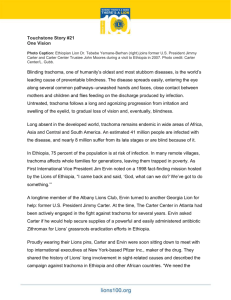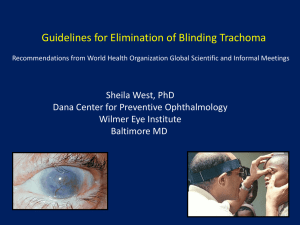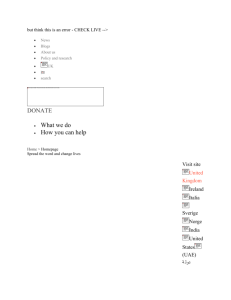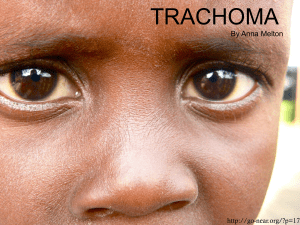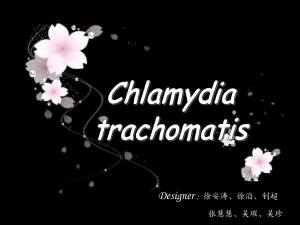Controlling Trachoma in Morocco Case 10
advertisement
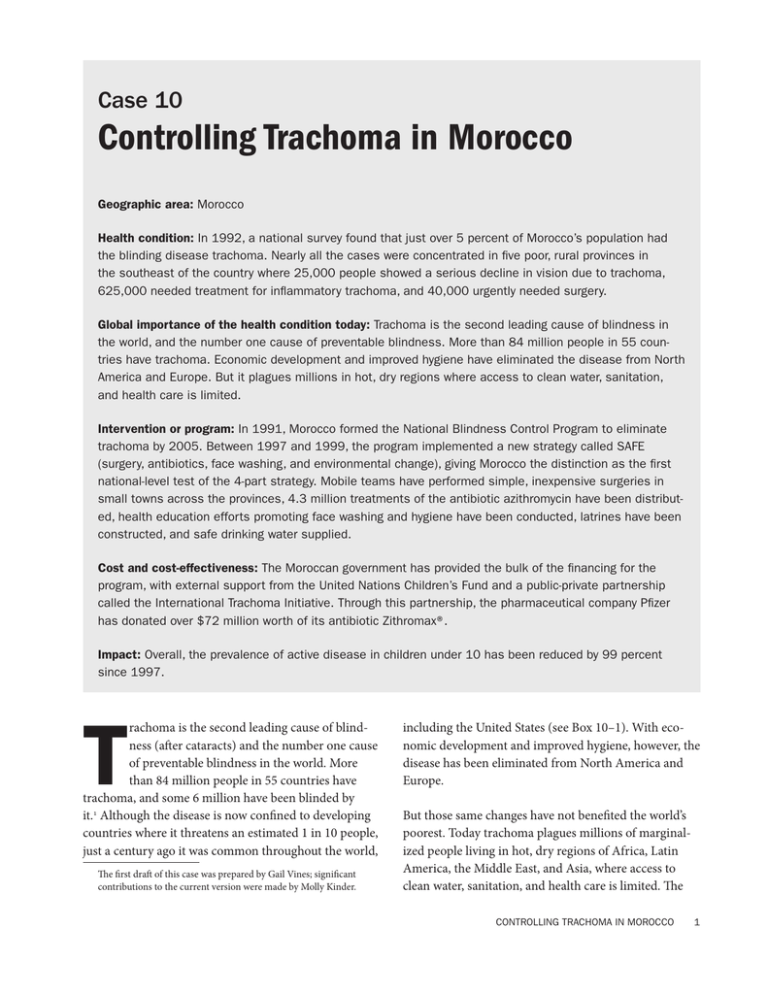
Case 10 Controlling Trachoma in Morocco Geographic area: Morocco Health condition: In 1992, a national survey found that just over 5 percent of Morocco’s population had the blinding disease trachoma. Nearly all the cases were concentrated in five poor, rural provinces in the southeast of the country where 25,000 people showed a serious decline in vision due to trachoma, 625,000 needed treatment for inflammatory trachoma, and 40,000 urgently needed surgery. Global importance of the health condition today: Trachoma is the second leading cause of blindness in the world, and the number one cause of preventable blindness. More than 84 million people in 55 countries have trachoma. Economic development and improved hygiene have eliminated the disease from North America and Europe. But it plagues millions in hot, dry regions where access to clean water, sanitation, and health care is limited. Intervention or program: In 1991, Morocco formed the National Blindness Control Program to eliminate trachoma by 2005. Between 1997 and 1999, the program implemented a new strategy called SAFE (surgery, antibiotics, face washing, and environmental change), giving Morocco the distinction as the first national-level test of the 4-part strategy. Mobile teams have performed simple, inexpensive surgeries in small towns across the provinces, 4.3 million treatments of the antibiotic azithromycin have been distributed, health education efforts promoting face washing and hygiene have been conducted, latrines have been constructed, and safe drinking water supplied. Cost and cost-effectiveness: The Moroccan government has provided the bulk of the financing for the program, with external support from the United Nations Children’s Fund and a public-private partnership called the International Trachoma Initiative. Through this partnership, the pharmaceutical company Pfizer has donated over $72 million worth of its antibiotic Zithromax®. Impact: Overall, the prevalence of active disease in children under 10 has been reduced by 99 percent since 1997. T rachoma is the second leading cause of blindness (after cataracts) and the number one cause of preventable blindness in the world. More than 84 million people in 55 countries have trachoma, and some 6 million have been blinded by it.1 Although the disease is now confined to developing countries where it threatens an estimated 1 in 10 people, just a century ago it was common throughout the world, The first draft of this case was prepared by Gail Vines; significant ­contributions to the current version were made by Molly Kinder. including the United States (see Box 10–1). With economic development and improved hygiene, however, the disease has been eliminated from North America and Europe. But those same changes have not benefited the world’s poorest. Today trachoma plagues millions of marginalized people living in hot, dry regions of Africa, Latin America, the Middle East, and Asia, where access to clean water, sanitation, and health care is limited. The Controlling Trachoma in Morocco Box 10–1 Trachoma in the United States At the end of the 1900s, the threat of trachoma was very real in the United States. The disease was rampant in crowded slums in both the United States and Europe during the Industrial Revolution, and New York newspapers commonly ran public health notices warning about the disease’s communicable nature. Trachoma became a criterion for excluding immigrants from the United States, causing more than 36,000 immigrants to be denied entry between 1897 and 1924. The US Public Health Service launched an ambitious campaign to control the disease in the “trachoma belt” in the southeastern states. A public education campaign was initiated, and hospitals to treat trachoma were established. In the 1960s, after several decades, trachoma was finally eliminated from the United States.2 heaviest burden of blindness from trachoma affects the populations of sub-Saharan Africa. Modern antibiotics, combined with prevention and other treatment methods that can be deployed in low-income countries, hold much promise in the fight against trachoma. Morocco, the first country to start a large-scale campaign against trachoma with a newly developed strategy, is at the threshold of eliminating blinding trachoma. Disease of Poverty Trachoma is highly contagious, marked by chronic conjunctivitis, or “pink eye.” Children are its first victims. Active infection is caused when the bacterium Chlamydia trachomatis is spread (mainly among young children) through direct contact with eye and nose secretions from affected individuals, contact with contaminated towels and clothing, and through fluid-seeking flies. Disease transmission is rapid and intense in conditions of overcrowding, poor hygiene, and poverty. In endemic areas, prevalence rates in children aged 2 to 5 years can reach 90 percent.2 Controlling Trachoma in Morocco Active trachoma alone is not immediately threatening to sight. Repeated trachoma infections over many years, however, cause problems that can eventually lead to blindness. The upper lid frequently becomes chronically inflamed, resulting in scarring and a condition called “trichiasis,” or in-turning of the eyelash. If this condition is not treated, the eyelash painfully rubs the eye, resulting in corneal scarring, opacity, and blindness. Blindness from trachoma, whose seeds are first sown in early childhood, usually strikes when a person is between 40 and 50 years old. Trachoma is linked closely with poverty—both as a symptom of underdevelopment and as a cause. The disease disproportionately affects women, who are infected through their close contact with children; women contract trachoma at a rate two to three times more frequently than men. The economic impact of trachoma on endemic areas is profound, as blindness develops during the most economically productive years. An estimated $2.9 billion worth of potential productivity is lost annually due to the disease.3 New Strategy: SAFE In the mid-1980s, the Edna McConnell Clark Foundation brought renewed attention to trachoma by funding extensive research on the disease’s epidemiology and the viable options for its control. The scientific findings contributed to the development of a new, comprehensive strategy to treat and prevent trachoma. This strategy was called “SAFE,” which stands for surgery, antibiotics, facial cleanliness, and environmental change—the four main interventions. The community-based SAFE strategy seeks to confront the underlying causes of the disease as well as the imminent threats of blindness, and differs from earlier approaches by emphasizing the need to effect not just medical but also behavioral and environmental changes. Surgery Surgery is needed to halt corneal damage in the later stages of trichiasis and prevent the onset of blindness. Researchers in Oman designed a simple, quick, and inexpensive surgical procedure, which can be applied to treat large numbers of patients at the community level. Health professionals are trained to make a slit in the outer part of the eyelid and restitch it in a way that pulls the edge and lashes away from the eye’s surface. The simple procedure has a success rate of approximately 80 percent, and in low-income countries like Ghana can cost as little as $6 per person.2 Antibiotics Antibiotics are used to treat active trachoma infections and can reduce the community pool of infections and prevent scarring.4 Until the discovery of the one-dose azithromycin, the available antibiotic was a 1 percent topical tetracycline eye ointment applied daily in a 6- to 4-week regimen. Because of the time-intensive treatment and its side effects of stinging sensations and blurred vision, however, compliance with the earlier treatment was often poor. Facial Cleanliness Studies have shown that clean faces, especially among children, can break the cycle of reinfection and prevent the spread of trachoma-causing bacteria. Washing helps remove the discharge from infected eyes, which attracts disease-spreading flies seeking fluid and salt. Children’s faces can be kept clean even with small amounts of water—one liter can clean as many as 30 faces. Environmental Change Improving living conditions and community hygiene has reduced the spread of trachoma. Construction of latrines is an important way to reduce the prevalence of the flies associated with trachoma.4 Health education and the provision of adequate water have also proven effective in reducing the spread of infection. Medical Breakthrough and International Movement A major advance for the SAFE strategy occurred in the mid-1990s with the discovery of a much more potent antibiotic, which strengthened the strategy’s “A” component. Studies showed that a single dose of the antibiotic azithromycin was as effective as (or even more effective than) the 6-week regimen of the widely used tetracycline antibiotic. Pfizer, the global pharmaceutical giant that manufactures the prescription version of the drug (Zithromax®), and the Clark Foundation began pilot tests of the drug in the early 1990s in Africa. Their results established that the drug is a powerful 1-dose cure and a substantial improvement over the tetracycline ointment treatment because it assures a higher adherence rate. With the discovery of azithromycin and the development of a comprehensive strategy to prevent and treat the disease, the global health community now had powerful weapons in the fight against trachoma. The mounting evidence demonstrating the feasibility of eliminating trachoma was first outlined in a 1996 WHO global scientific meeting. Momentum was boosted further in 1998 when Pfizer and the Clark Foundation announced the formation of a public-private partnership called the International Trachoma Initiative (ITI) aimed at eliminating blinding trachoma worldwide. The initiative was first financed with $3.2 million grants from each of the two main partners and set out to help governments of endemic countries start national trachoma programs based on the SAFE strategy. Pfizer’s pledge to contribute $60 million worth of Zithromax® was key to ITI’s strategy and represented a shift in the company’s philanthropy. Zithromax® has a broad consumer market and is the most prescribed branded oral antibiotic in the United States, accounting for more than $1 billion annually of the company’s revenues.5 The company donated large quantities of the drug, despite the risk that the donated drugs could be sold on the black market. With funding, leadership, momentum, and a strategy in place, the international movement embarked in 1999 on the first national-level test of the SAFE strategy, choosing Morocco as the site. Morocco Leads the Fight Against Trachoma Morocco, a North African country of just under 32 million people, has a long history of trachoma control efforts. The country’s fight against the disease began nearly a century ago, when the disease ravaged all parts of the country. Dr. Youssef Chami Khazrazi, head of Morocco’s National Blindness Control Program (NBCP), wrote, “There is not a single Moroccan among two to three Controlling Trachoma in Morocco generations who does not remember the years where the fight of [trachoma] represented one of the major and permanent activities of the Ministry of Health.”6 Initially, the disease was regarded as primarily a medical problem, and in the 1970s and 1980s it was tackled by treating schoolchildren in the most-affected provinces with tetracycline eye ointment twice a year. Medical treatment was not yet integrated with improvements in sanitation and standard of living among the rural poor. Therefore, while economic development led to the virtual disappearance of trachoma from most urban areas in the previous few decades, the disease pervaded many of the country’s poorer, rural areas. A national survey in 1992 found that approximately 5.4 percent of the population showed signs of trachoma, with virtually all of these cases concentrated in five rural provinces in the southeast of the country: Errachidia, Figuig, Ouarzazate, Tata, and Zagora. These five arid provinces constitute a quarter of the total area of the country and have a widely dispersed population of approximately 1.5 million people. Poverty, scarce water, agricultural subsistence, and weak infrastructure and sanitation characterize the region. There, the problems of trachoma were great: 25,000 people showed a serious decline in vision due to trachoma; some 625,000 needed treatment for inflammatory trachoma; and surgery was urgently needed for 40,000 people with trichiasis. Morocco’s political leaders were committed to eliminating trachoma by 2005, and in 1991 formed the National Blindness Control Program (NBCP). Between 1997 and 1999, the SAFE strategy was integrated into the program. “We now recognized,” says Dr. Khazrazi, “that trachoma at the level of these regions is not strictly a medical problem; it is essentially the reflection of a socioeconomic problem.” The “real enemies,” he explains, “are the disfavored rural communities, illiteracy, family overcrowding, lack of water, the accumulation of animal wastes, and the proliferation of domestic flies. In sum, the enemy to combat is not Chlamydia but poverty.”6 To address the disease’s wide-ranging causes, the NBCP formed a comprehensive partnership including five government divisions (Ministry of Health, Ministry of National Education, Ministry of Employment, Ministry of Equipment, and National Office for Potable Water), Controlling Trachoma in Morocco international organizations (ITI, UNICEF, WHO, and Helen Keller International), bilateral and multilateral agencies, and local nongovernmental organizations. With scientific evidence, political resolve, and financial support in place, the NBCP was launched. Putting SAFE in Motion Each of the four elements of the SAFE strategy was mobilized. Surgery Government officials in the Ministry of Health moved quickly to decentralize surgery so that eyelid correction was readily available in small towns and villages. Before surgical teams arrived in the countryside, village leaders and outreach workers were briefed so that they could publicize the procedure and explain its benefits. In partnership with the Hassan II Foundation of Ophthalmology, the ministry deployed mobile surgical units staffed by doctors and specialist nurses trained to carry out the vision-saving procedures. Forty-three physicians and 119 nurses have worked in 34 centers throughout the five provinces. Between 1992 and 2005, more than 40,000 people underwent eyelid surgery. At the same time, education campaigns were launched to motivate infected individuals to come forward for treatment. Antibiotics Azithromycin was first field tested in Morocco during the mid-1990s, when 10,000 patients were successfully treated. Widespread treatment with the donated drug began in the five southeastern provinces in 1999, and approximately 4.3 million doses have been distributed to date (ITI statistics through December 2005). A successful strategy was soon developed, built on the recognition that trachoma is a community disease and reinfection is very likely to occur if only isolated cases are treated. Different approaches were developed depending on the prevalence. When more than one fifth of the children under 10 showed signs of active trachoma, everyone in the community was treated. Where infection rates were lower—between 10 and 20 percent—treatment focused on affected children and their families; at less than 10 percent, infections were treated individually. Treatment campaigns were launched annually, between the months of September and December. Facial Cleanliness Health education has proven effective in increasing awareness and changing attitudes, thus increasing clean faces and preventing disease transmission. Campaigns promoting individual and community hygiene have centered on information, education, and communication to explain the causes of the disease and the means of prevention. Outreach workers, health professionals, and teachers have used slide shows, videos, films, community theater, meetings, photos, notices, pamphlets, and even megaphones to communicate the messages. Newspaper articles and radio and television broadcasts have also been effective. To educate children, the primary carriers of the disease, the Ministry of Education designed a model lesson on trachoma that was incorporated into the curriculum of primary schools in the five provinces. The education campaigns depend in large part on the active engagement of the local community. Mosques, lodgings for young women, local associations, and schools have proved to be ideal venues for communicating the campaign’s message. Environmental Change The National Office for Potable Water has overseen the construction of latrines in 32 villages. Supporting these Figure 10–1 Percentage Prevalence of active disease in five provinces in Morocco, 1997–2004. 80 70 60 50 40 30 20 10 0 1997 Zagora Errachidia 1999 2001 Tata 2003 Ouarzazate 2004 Figuig Note: In Morocco, the prevalence of active disease in children under 10 has been reduced by 99 percent. Source: Ministry of Health, Morocco (2006). efforts are 350 local village associations that have drilled wells, built latrines, and found safe ways of storing animal dung, so that this valuable natural fertilizer does not spread flies through the village. The national office is also leading the provision of drinking water: 74 villages in Errachidia and Zagora have been supplied with water, and access to potable water is reported to have increased from 13 percent of all rural communities in 1992 to 60 percent in 2000 to at least 80 percent in each trachoma endemic region as of 2005. Interventions to reduce poverty and improve literacy among women are now acknowledged to be central to the fight against trachoma. In Zagora, for example, the work of the Ministry of Employment and Helen Keller International has helped 8,500 women learn to read. Helen Keller International has also implemented economic programs aimed at increasing the incomes of women. Blinding Trachoma Nearly Eliminated The implementation of the SAFE program has had a dramatic impact in Morocco and represents the most rapid elimination of blindness due to trachoma in a single country in history. Prevalence has fallen 99 percent since 1997, from 28 percent to just less than 2.5 percent in 2005.7 Acute infections have been significantly reduced in children and in some places, such as Figuig and Ouarzazate, eliminated. In Zagora province, which remains the hardest hit, annual epidemiological surveys beginning in 1997 revealed a drop in prevalence from 69 percent to 3.3 percent in 2004. In Tata, Ouarzazate, and Figuig provinces, no cases of active infection have been reported since 2003. Overall, the intervention has achieved a 99 percent reduction in the prevalence of active disease in children under 10 since 1997 (see Figure 10–1). Morocco has reached its “ultimate intervention goals” and has reduced the burden of disease to the trachoma elimination target levels set by the WHO: less than 5 percent prevalence of active disease in children 1 to 9 years of age and less than 0.1 percent trichiasis in adults over the age of 15. The next phase is surveillance of the disease to ensure that levels remain below these targets. Once this is sustained, Morocco will apply for WHO certification of elimination of blinding trachoma. Controlling Trachoma in Morocco Cost The elements of the SAFE strategy that are most expensive are improving environmental infrastructure and providing the drugs. Although quantitative information about total spending on the initiative is unavailable, to date the Moroccan government has provided the bulk of the funds to improve village sanitation—supplemented with grants worth over $2 million from ITI between 2001 and 2004. The dramatic reduction in trachoma achieved in Morocco over the past few years would probably have been impossible without Pfizer’s donation of the antibiotic, valued at around US$72 million. The company has also provided grants for public education to support other components of the SAFE strategy. The US Fund for UNICEF has supported the implementation of the face cleanliness and environmental change components of the SAFE strategy with a grant of $225,000. Total costs for surgical treatment have been estimated at $15 to $25 per person, with funding from the Moroccan government as well as ITI, worth between US$440,000 and US$730,000. A further grant from ITI—$180,000 from 2000 to 2004—supported the Moroccan Ministry of Health’s evaluation of the impacts of interventions. The Final Stages: Maintenance and Surveillance Morocco’s SAFE program has succeeded in slashing the prevalence rate of active trachoma among children and clearing the backlog of surgeries. The effort to eliminate blinding trachoma from Morocco has thus entered its final, and crucial, stage: maintenance and surveillance before being certified by WHO as having eliminated blinding trachoma. This entails the early identification of active trachoma cases and prompt treatment of those infected in order to prevent spread of the disease. Identification of infected patients can occur during health visits, such as at maternal and child health clinics; through sentinel site activities; and through the reporting of suspected cases to local partners in trachoma control, such as local NGOs, teachers, health personnel, and the Red Crescent Society. Immediately following the diagnosis of an active trachoma case, a visit is made Controlling Trachoma in Morocco to the household where all members are examined for infections and, if needed, treated with antibiotics. It can often take years of repeated infections to cause scarring of the upper lid and trichiasis, or inversion of the upper lid that precedes blindness, so surgery cases will continue to emerge even after active trachoma is interrupted in Morocco. Community leaders and organizations such as the Red Crescent Society will continue to play an important role in locating and reporting trichiasis cases to district surgical teams. Because of the expected emergence of a limited number of new cases of active trachoma and trichiasis, the need for an effective epidemiological surveillance system for trachoma is great. All new cases are reported to the district health departments by village sentinel sites and health facilities. Periodic reviews are conducted, with the results shared with provincial and central authorities. Unless unforeseen epidemics occur, this surveillance phase is expected to continue until 2009. Elements of Success Dr. Jacob Kumaresan, the president of ITI, has identified three factors as the keys to Morocco’s success in the elimination of blindness due to trachoma, which can be an inspiration for other trachoma endemic countries.9 First, government buy-in exists at all levels of the national blindness control program. Second, the program developed strong public-private partnerships, including a network of NGOs and local associations; and third, the government has taken an aggressive approach to provision of safe drinking water and improved sanitation for at-risk populations. Dr. Khazrazi also reported that the solid support of the government of Morocco was invaluable. “One of the major assets is commitment and political will. Political will is, first of all, the commitment of the Ministry of Health.” This support is evidenced by frequent periodic visits of ministry officials to endemic areas to affirm the government’s commitment to the disease’s elimination. Catalyst for Global Efforts The success of the trachoma program in Morocco has provided a catalyst for efforts to eliminate the disease worldwide. Robert L. Mallett, senior vice president of corporate affairs of Pfizer’s international philanthropy department, explained that Morocco’s program “made history by completing their mass antibiotic and surgical campaigns, signaling the beginning of the end for a disease that has plagued the country for centuries.” In 2000, after data demonstrated that prevalence rates in Morocco had been reduced by more than half in just one year, the ITI accelerated its international efforts. Pfizer committed to donating 10 million additional doses of Zithromax® and $6 million in operational funding, the Clark Foundation contributed another $6 million, the UK Department for International Development provided approximately $1.8 million, and the Bill & Melinda Gates Foundation awarded $20 million over five years—the foundation’s largest donation to date to international blindness. With the additional funding in place, the SAFE strategy was initiated in Tanzania, Mali, Sudan, Ghana, Vietnam, Ethiopia, Nepal, Niger, Mauritania, Senegal, and Kenya. In these countries, representing one quarter of the global burden of trachoma, 221,000 surgeries have been performed and around 36.7 million doses of Zithromax® were distributed (ITI statistics, through December 2005). In November 2003, recognizing the effectiveness of the SAFE strategy and the need to scale up programs, Pfizer announced that it would donate up to 135 million doses of Zithromax® over the next five years.8 Pfizer’s contribution represents one of the largest donations of a patented drug in history. According to Pfizer’s Chairman and CEO Hank McKinnell, “By 2020 we hope to have all of (the endemic countries).” Thus, ITI and its many partners have helped ensure that Morocco’s success with SAFE, like the disease that it has nearly eliminated, is contagious. 3. Frick K, Hanson C, Jacobson G. Global burden of trachoma and economics of the disease. Am J Trop Med Hygiene. 2003;69(suppl 5):1–10. 4. West S. Blinding trachoma: prevention with the SAFE strategy. Am J Trop Med Hygiene. 2003;69(suppl 5):S18–S23. 5. Barrett D, Austin J, McCarthy S. Cross-Sector Collaboration: Lessons from the International Trachoma Initiative. Paper presented at: Workshop on PublicPrivate Partnerships in Public Health; Endicott House, Dedham, Mass; April 7–8, 2000. 6. Khazraji YC. Revival in the fight of trachoma: ten years of fight in the Kingdom of Morocco, 1991– 2001. 2002 report of the French League Against Trachoma and International Organization Against Trachoma. Available at: http://www.cgdev.org/doc/ millions/Trachoma_in_Morocco.pdf. Accessed December 13, 2006. 7. Ministry of Health, Morocco. Presentation at the Global Elimination of Blinding Trachoma 2020 meeting, Geneva, Switzerland; April 10, 2006. 8. Donnelly J. Pfizer to donate US$500 million in drugs. Boston Globe. November 12, 2003. 9. Kumaresan J, Mecaskey J. The global elimination of blinding trachoma: progress and promise. Am J Trop Med Hygiene. 2003;69(suppl 5):S24–S28. References 1. Mariotti S. New steps toward eliminating blinding trachoma. N Engl J Med. 2004;351;19:2004–2007. 2. Mecaskey J, Knirsch C, Kumaresan J, Cook J. The possibility of eliminating blinding trachoma. Lancet Infect Dis. 2003;3(11):728–734. Controlling Trachoma in Morocco
